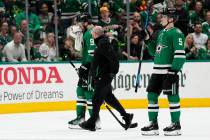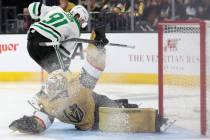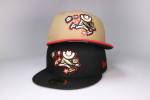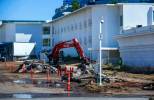Team can’t wait much longer for new park
The clock ticked quietly before. Now you can hear it from Summerlin to Henderson and beyond. Don Logan officially welcomed the Toronto Blue Jays to town Monday, but far more important than any two-year Triple-A affiliation agreement is the next three to six months.
That's how long the 51s president/general manager and the team's ownership group and any community support they can extract likely have to finalize plans for a new ballpark, to finally rid minor league baseball here of that obsolete facility with its undersized locker rooms and metal bleachers and no relief from the summer heat and an inadequate number of restrooms and a food and beverage service that doesn't have anyone breaking speed limits to arrive early.
It's about replacing archaic Cashman Field more than ever today.
The team's lease at Cashman also expires in two years, and Logan believes it's achievable to begin playing in a new downtown venue by 2011. Dreaming of it is one thing. Paying for it is quite another.
This is a tough one. The 51s drew 374,780 fans in 2008, their third-highest total in 26 years and still only about 12,000 more than their inaugural season. They have never drawn 400,000 in a given year, amazing when you consider they have been housed in one of the nation's fastest-growing regions.
How much of Cashman's decline over the years led to such stagnant numbers at the gate is debatable, but it's true the place is about as kid-friendly as a morgue. The 51s do a solid job on the promotions side, but bobbleheads don't have the same appeal when you have to sit in a dump to receive one.
(The Thursday night $1 beer, I am told, tastes the same no matter how dismal the setting.)
New ballparks not only transcend baseball with construction of surrounding commercial and residential buildings that in turn create revenue streams, but also offer amenities a family of four seeks when deciding to spend the money on attending games.
Diehards always will come to watch the 51s, but a new ballpark could potentially attract tens of thousands of mainstream fans over the course of a season.
It also comes with a projected price tag of between $40 million and $50 million.
Logan said any new ballpark would be built through a public/private partnership, and it's the public part that should rightly make you concerned in economic times worse than Lane Kiffin's job security.
Not many would rank a new stadium for the 51s over, say, finding spare change for gasoline and knocking on wood each time another foreclosure sign goes up in the neighborhood.
But facilities like the one Logan envisions (a minor league ballpark on a large enough piece of land that it could be converted into a major league stadium should a team relocate here) can be built without taxpayers being the ones to write the largest check.
It's up to those planning such a venue to discover ways -- various bonding options, tax increment financing, negotiating land and infrastructure needs at reduced rates, visitor taxing alternatives such as those on rental cars -- that make fiscal sense in such bleak times.
It would aid Logan's position if Oscar Goodman showed more genuine interest, but if the mayor was ever going to be at the front of such an endeavor, he would have been so years ago.
Goodman has obviously never accepted the reality that to acquire the major league sports franchise he has long coveted, it's often best to prove yourself with a top-notch minor league outfit and facility, a truth that directly led to Memphis and Oklahoma City getting NBA teams after those cities built pristine Triple-A ballparks.
Even Monday, Goodman spoke at a weekly news conference more about luring a major league baseball team than building a Triple-A ballpark. Of course, he also talked about his past discussions with the "Miami Marlins," so I'm not sure he's the point man Logan should desire anyway.
Las Vegas isn't Memphis or Oklahoma City. It's a different animal where the casino industry fulfills a large portion of the entertainment needs. But even the hint of losing a local sports franchise rarely can be painted in a positive manner, and you get the feeling it's now-or-never to make something happen with this team in this town.
Padres. Dodgers. Blue Jays. Whatever. None of it matters. Nicknames and uniform colors and affiliations mean as much for Triple-A baseball in Las Vegas as give-up run plays on third-and-25.
It all comes back to the same outdated facility. To the lovable dump that is Cashman Field.
"We have to get back to building and growing and being aggressive and not making the same mistakes that led to this financial downfall," said Logan, whose meetings with community leaders the past few weeks have caused him to believe building a ballpark is now better than a 50-50 proposition.
"We can learn from it and move forward or sit back and do nothing," Logan said. "I think we can get this (ballpark) done. This community deserves it."
His is obviously a vested opinion, but several Triple-A facilities have been built and worked elsewhere without financially crippling any township. If Logan and others can find a way to do it locally, it's the best move.
Because regardless how much Goodman wants it, the Miami Marlins aren't moving here any time soon.
Ed Graney can be reached at 383-4618 or egraney@reviewjournal.com.





























